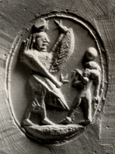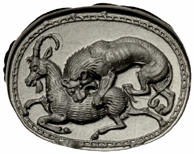Eastern and Phoenician
2
Agate conical stamp seal.
9.5 (height); 12.5x11.
Published: RA 1971, 195-6, fig. 1.
A lion-headed figure holding a staff and an ankh; disc-and-crescent.
Probably Syrian, 7th cent. BC.
3
Lapis lazuli scaraboid, pierced across the stone.
17x11.
Published: RA 1971, 196, fig. 2, with previous literature. J. Boardman, Classical Phoenician Scarabs (2003) no. 5/X5.
A four-winged beetle holding a winged disc over its human head; a smaller disc held in its hind legs. A symbol of the sun. Line border. Inscribed in Hebrew blth, its owner's name.
Phoenician, 6th cent. BC.
4
Green jasper scarab.
13.5x10.
Published: RA 1971, 197, fig. 3; Boardman, op.cit., no. 11/47.
Two-winged Isis, with a disc-and-uraei crown and holding flowers, stands before Horus, falcon-headed, disc-crowned and holding a flail and ankh (?). Line border; hatched exergue.
A typical egyptianizing example of a Classical Phoenician scarab, 5th cent. BC.
5
Quartz scarab.
15x11.
Published: RA 1971, 197, fig. 4; LIMC Herakles no. 2814; Boardman, op.cit., no. 32/X16.
Herakles with his lionskin at his neck raises his club and holds out his bow over a cowering warrior, helmeted, with spear and shield. Hatched border.
Another Classical Phoenician scarab, but with a totally hellenizing subject, about 500 BC.
6
Green jasper scarab.
13x10.
Published: RA 1971, 199, fig. 6; Boardman, op.cit., no. 39/50.
A lion attacks a goat. The lion's head is rendered in a combination of frontal and profile view, giving an impression of three-quarters. Hatched border.
Purely Greek style for a Classical Phoenician scarab, with the typical 'pinched back' of the class. Early 5th cent. BC.














